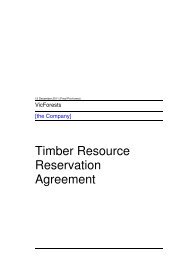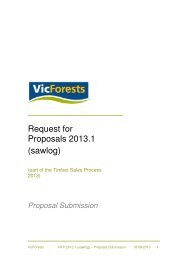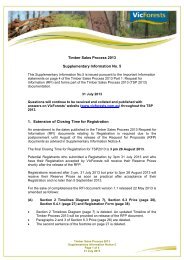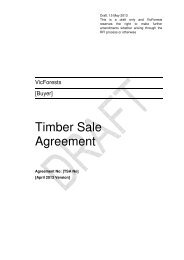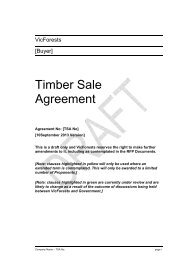Module 5 - VicForests
Module 5 - VicForests
Module 5 - VicForests
Create successful ePaper yourself
Turn your PDF publications into a flip-book with our unique Google optimized e-Paper software.
4 3BAudit Findings<br />
<strong>VicForests</strong> stated that large quantities of bark had been left on some landings due to the usual<br />
practice of undertaking regeneration burns, during which the bark heaps would be burnt. However, in<br />
order to reduce the incidence of burning, <strong>VicForests</strong> has initiated assessment of regeneration, and if<br />
regeneration is adequate, do not undertake the burn. As a result, bark heaps have remained unburnt<br />
and in the cases identified in the audit, exceed the prescribed bark volume limits.<br />
Recommendation 4 – It is recommended that <strong>VicForests</strong> builds into its systems a process for ensuring<br />
that excess bark is not retained around landings in the absence of regeneration burning.<br />
Failure to fill in a trench dug to store logs on one coupe (C21) and rip lines being spaced wider than<br />
the maximum prescribed (C11) resulted in non-compliances with EIA risk ratings of Minor and<br />
Negligible respectively.<br />
Whether topsoil had been stockpiled appropriately during landing construction was unable to be<br />
assessed during the audit on 11 coupes, due to the stage of the operations and the natural or fire<br />
induced paucity of topsoil at some of these locations. Whether the required depth of ripping had been<br />
achieved was unable to be determined at five coupes, as while the depth was assessed as less than<br />
required at the time of the audit, it had been up to two years since ripping had been undertaken and<br />
some degree of natural compaction would be expected during that time.<br />
The audit was unable to assess whether the landing on one coupe (C8) had been appropriately<br />
rehabilitated, as it was observed to have been excavated, according to <strong>VicForests</strong> staff, to provide fill<br />
for construction of another road. Assessment of this activity was outside the scope of this audit.<br />
Snig and forwarding tracks<br />
Snig and forwarding tracks were generally assessed as having been managed appropriately, with<br />
some issues identified with rehabilitation. The Auditor noted a good example of the minimisation of<br />
snig tracks and their impact (C12) and particularly good examples of rollover drains with effective<br />
outlet channels on a relatively steep slope (C14), constructed using an excavator (Refer to Appendix<br />
K, Photograph 17).<br />
Generally, rehabilitation of snig tracks after harvesting was assessed as being well managed, with<br />
appropriate spacing of effective drainage structures. A total length of 5,894 m of snig tracks was<br />
assessed across 23 coupes, with 4,773 m assessed as compliant. The sampled length of snig track<br />
was assessed as compliant on 15 coupes. In some of these compliant coupes, potential for<br />
improvement in the design of drainage structures was noted, but due to the soil type and/or<br />
topography, were considered adequate. In most of the compliant coupes, rollover drains had been<br />
constructed to a high quality, with effective outlets to channel water away from the track.<br />
42807504/01/01 49




